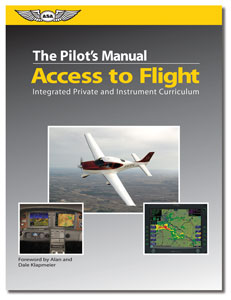Whether you fly for pleasure, business, or a career in aviation, the Private Pilot certificate with the Instrument Rating is your ticket into the full spectrum of the airspace system — it is the key to maximizing the utility of a general aviation aircraft. This book provides the information you need to learn how to fly under both visual flight rules (VFR) and instrument flight rules (IFR). The most comprehensive pilot textbook available, The Pilot's Manual: Access to Flight provides efficient training methodology that helps you graduate with a truly successful personal transportation solution.
Technically Advanced Aircraft (TAA) demand a level of understanding and functional proficiency as never before. This breakthrough course is simply the most efficient and comprehensive way to prepare for flight in TAA and today's increasingly complex flight environment. In addition, chapter review questions will help prepare you for the FAA Private and Instrument Knowledge Tests.
The Private and Instrument curriculums are integrated in this training approach, so pilots flying TAA learn to intrinsically manage the combined skills of aircraft control, task management, systems management, and the complex flight environment of today's busy airspace; a different approach from traditional maneuver-based flight training.
General aviation has undergone an extraordinary transformation in recent years. EFIS (electronic flight instrument system) or “glass” cockpit-equipped aircraft, once the exclusive realm of airline, corporate, and military pilots, have now proliferated the GA landscape. In what seemed like the blink of an eye, pilots and instructors accustomed to flying aircraft equipped with conventional gauges that hadnt changed much in almost 50 years were now sitting behind sophisticated systems with glowing displays, comparable only to some of the most advanced airliners and corporate jets. These second generation “Technically Advanced Aircraft” (TAA) literally represented the coming of a new age and the promise of nearly unlimited potential. At the same time however, the arrival of these sophisticated aircraft created an unprecedented training and operational challenge never experienced in GA. The Pilot's Manual: Access to Flight has been specifically crafted to meet this challenge, making use of methods that will allow pilots to obtain the maximum safety and utility from their aircraft.
For the first time ever, Private and Instrument curriculums are integrated so pilots flying TAA learn to intrinsically manage the combined skills of aircraft control, task management, systems management, and the complex flight environment of todays busy airspace. This is a very different approach from the practice of traditional maneuver-based flight training used heretofore. With a realization of the inadequacy of maneuver-based training as applied to TAA, The Pilot's Manual: Access to Flight embodies the state-of-the-art industry training standards of scenario-based training (SBT), learner centered grading and involvement, and single pilot resource management (SRM). These are real world skills, taught with a train-like-you-fly, fly-like-you-train philosophy, treating each and every lesson as a "real" flight. This is where harnessing the power of all available resources and aeronautical decision making (ADM) become second nature. Whereas maneuver-based training focused specifically on simply learning to control the aircraft, this new methodology involves considering an entire flight, and all its component aspects, from beginning to end.
Table of Contents
The Pilot
1. Airmanship
2. Human in the Cockpit
3. Aviation Regulations
Aerodynamics
4. Forces Acting on an Airplane
5. Stability and Control
6. Aerodynamics of Flight
The Airplane
7. Airframe
8. Engine
9. Systems
10. Flight Instruments
11. Weight and Balance
Navigation
12. Charts
13. Airports and Airport Operations
14. Visual Navigation Fundamentals
15. GPS
16. Radar and ADSB
17. VOR
18. Airspace
19. Flight Planning
Instrument Flight
20. Introduction to Instrument Flight
21. IFR Departure
22. Enroute
23. Instrument Approaches
24. Visual Maneuvering
25. VOR and Radar Approaches
26. GPS Approaches
27. ILS Approaches
28. Holding Patterns, DME arc
29. Partial Panel
Weather
30. Wind, Air Masses, and Fronts
31. Visibility
32. Clouds
33. Icing
34. Thunderstorms
35. High-Level Meteorology
36. Weather Reports and Forecasts
